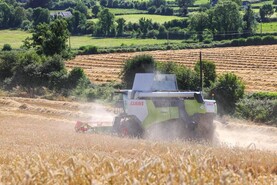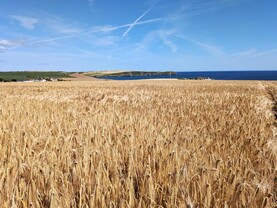The winter barley harvest finished over the weekend for Pádraig. The farm averages came in at 3.7t/ac at 21% moisture and 63 KPH.
This ranged from KWS Tardis at 4t/ac and 65 KPH, to an Integral seed crop at 3.75t/ac and a KPH of 61 and KWS Joyau at 3.6t/ac and 62KPH. Pádraig also had two fields of Integral for feeding. One field planted on 28 October did 3.8t/ac, while the other, planted on 11 November, yielded 3.3t/ac, both at a hectolitre weight of 62.
Some of the barley was cut with higher moistures, around 22%-23%, but Pádraig says that every opportunity had to be taken this year. While he got good yields, he says that the potential of the crops was higher but the grains did not fully fill, as can be seen by the lower hectolitre weights.
Some of the straw was chopped and incorporated. The six-row crops yielded 10 round bales per acre, while Pádraig was expecting the two-row yield to be higher when baled.
Pádraig will plant 20ha of cover crops this week on land that is destined for spring barley.
He will plant an eight-way mix, which he feels will do more for the soil than the standard forage rape and leafy turnip mix and he gets better establishment too as the two-way mix gets attacked by slugs on his farm.
The winter wheat is about two weeks away from harvest. This will be followed by the spring barley, which is starting to change colour. It looks quite heavy and is starting to hang over, but there is no lodging as of yet.
The spring oats are very green and are over a month from harvest. Pádraig says they are the pick of the spring crops. He will consider taking the spring oats out of the chopping scheme if the price is right and if the weather is good at the time of harvest. Pádraig says he has no major worries over the spring crops.
Barty was living in hope of good weather to begin his harvest over the past two weeks. Despite his winter barley being ripe for ten days by the weekend, there were no opportunities to cut in Wexford at moistures under 20%, with 15mm of rain in the gauge last week. Barty did harvest a sample but it was 21.5% moisture.
He would not cut at this moisture, especially because his winter barley is for malting. This sample was where BYDV had damaged the crop and the hectolitre weight was between 59 and 60kph.
The barley started breaking down last week. The heads haven’t gone fully to the ground, and Barty says that losses are not too high.
Thankfully, he finally got to harvest in good weather on Sunday. However, the crop was disappointing. The variety was Craft and was for malting. While the moisture was 17.5%, the bushel weight was down at 60.8 KPH, the screenings were over 10% and the protein was 11%.
This resulted in a yield of 2.5t/ac. Barty says this is due to the BYDV the crop has had throughout the year and the poor grain filling period. He says this is a common yield in his area and there is little above 3t/ac.
There is also a light swarth of straw. He was hoping to bale this in the past couple of days.
Barty had straw in the Straw Incorporation Measure but he says he will now be pulling out of it and baling the straw. He says the controversies over the past two weeks have divided farmers somewhat and it could easily have been avoided.
He also applauds the farming organisations for their work on getting the minister’s decision reversed.
The spring barley is turning fast but Barty thinks it won’t be ripe until after 15 August, which would be very late for his location and his light land.
The harvest has progressed well in Galway, with the winter barley finished on Tuesday before starting on the winter oats.
Conall is happy with how the barley has performed, with one field after beans yielding an exceptional 4.4t/ac, the best crop Conall has ever grown.
There have been other fields at 3.7t/ac, 3.5t/ac, 3.3t/ac, and 2.9t/ac, leaving the farm average somewhere between 3.6 and 3.8t/ac. The best of these crops are after break crops, while the poorer crops are after continuous cereals, showing the importance of a good crop rotation.
The moisture content has been between 17% and 21%, with an average of 18%. The only field that didn’t get Terpal broke down a lot before harvest, showing how useful the growth regulator can be.
Conall doesn’t know how the straw is yielding just yet, but says it is a bit back on previous years. He chopped one field because it was quite weedy and he didn’t want the hassle of getting it dry when there was a lot of wet, green material.
This was outside of the Straw Incorporation Measure, so there will be no payment on it. There are deep tramlines in most fields this year and Conall says they are a pain at harvest for the combine, the trailers, and the baler, with drivers being very careful going over these ruts.
Conall does not have any huge expectations for the spring crops due to the late planting.
The early sown spring barley is beginning to change colour but the later sown crops are still very green and are still far from harvest.
The spring oats are also very green. Conall notes that they are very short, the shortest oats he has ever seen. The spring beans are still green, but Conall says there has been a slight change in the past few days, so they may be just beginning to senesce.






 This is a subscriber-only article
This is a subscriber-only article









SHARING OPTIONS: